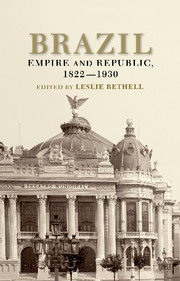2 - 1822–1850
Published online by Cambridge University Press: 05 June 2012
Summary
At the time of its independence from Portugal in 1822 Brazil had a population of between 4 and 5 million (if the Brazilian Indians numbering perhaps as many as 800,000 are included). This relatively small population was scattered over a vast territory of over 3 million square miles, but remained heavily concentrated in an area within 200 miles of the Atlantic coast from the provinces of the north-east (with 40–45 per cent of the total population) to Rio de Janeiro, Sãao Paulo and the south. The only inland province with a significant population was Minas Gerais which had been the focus of the gold rush in the first half of the eighteenth century and which still accounted for 20 per cent of Brazil's population, though most of it was located in the south of the province adjoining Rio. Some provinces of the interior like Mato Grosso had populations of less than 40,000. It was an overwhelmingly rural population. The largest city was the capital, Rio de Janeiro, with around 100,000 inhabitants; the second largest city, Salvador (Bahia), the former capital, had only 60,000, and half of the provincial capitals no more than 10,000 each. Conditions of health were very poor and average life expectancy low. The general level of education was also low. Education had never been a priority of Portuguese colonial policy. As late as 1872, when the first official figures became available, only a fifth of the free population was even literate.
- Type
- Chapter
- Information
- BrazilEmpire and Republic, 1822–1930, pp. 45 - 112Publisher: Cambridge University PressPrint publication year: 1989
- 4
- Cited by



